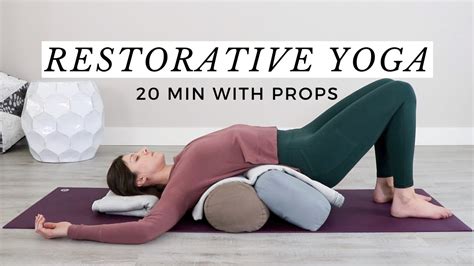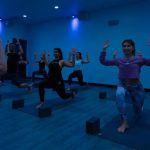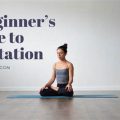Ultimate Guide to Restorative Yoga Poses for Deep Relaxation
Restorative yoga is a practice that promotes deep relaxation, mental clarity, and a profound sense of well-being. In a fast-paced world where stress and anxiety are rampant, restorative yoga serves as an antidote to the constant rush. By focusing on gentle poses supported by props, this style of yoga encourages the body to rest, heal, and rejuvenate. This guide will explore key concepts, historical background, practical applications, and more to offer a comprehensive understanding of restorative yoga for deep relaxation.
Introduction
In today’s stressful environment, people seek effective ways to manage anxiety and promote holistic well-being. Restorative yoga, a gentler counterpart to traditional yoga, emphasizes holding poses for extended periods with the use of props like bolsters, blankets, and blocks. This practice encourages a state of complete relaxation and helps the body heal from physical and emotional stress. Unlike other forms of yoga, restorative yoga is accessible to everyone, regardless of age or physical ability. It offers numerous benefits, from improved sleep to enhanced mental clarity, making it an invaluable tool for personal wellness.
Key Concepts
- Relaxation Over Effort: Restorative yoga prioritizes relaxation rather than physical effort. The goal is to achieve a state of deep rest where the body can recover naturally.
- Use of Props: Props such as bolsters, blocks, and blankets are used extensively to support the body in various poses, allowing for prolonged holds without strain.
- Extended Holds: Poses in restorative yoga are held for longer durations (5-20 minutes), which allows the body and mind to fully relax.
- Focus on Breathing: Breathwork is integral to restorative yoga, guiding practitioners into a meditative state and encouraging relaxation on a cellular level.
- Nervous System Reset: The practice activates the parasympathetic nervous system, leading to reduced stress, lower blood pressure, and improved digestion.
Historical Context
Restorative yoga emerged from the teachings of B.K.S. Iyengar, who emphasized the importance of props in yoga practice to make postures more accessible. In the 1970s, Judith Hanson Lasater, a student of Iyengar, further refined the practice into what we know today as restorative yoga. This practice is rooted in ancient yoga principles but adapted for modern lifestyles that often lack balance and stillness. By slowing down and focusing on mindful relaxation, restorative yoga offers a counterbalance to the intensity of our daily routines.
Current State Analysis
Restorative yoga has gained widespread popularity in recent years as more people look for ways to manage stress, reduce anxiety, and improve their overall well-being. It is often practiced in studios, wellness centers, and even hospitals due to its therapeutic effects. However, despite its popularity, there is a misconception that restorative yoga is “too easy” or not as beneficial as more physically demanding forms of yoga. In reality, the deep relaxation facilitated by restorative yoga can have profound effects on both physical and mental health.
Practical Applications
Restorative yoga can be practiced by anyone, anywhere. It requires minimal equipment, and many poses can be done at home with everyday items like pillows and blankets. Below are key practical applications of restorative yoga:
- Stress Relief: Regular practice reduces cortisol levels and promotes relaxation, making it a powerful tool for managing stress.
- Enhanced Sleep: Practicing before bed helps the mind and body prepare for a restful night’s sleep.
- Improved Focus: By calming the nervous system, restorative yoga enhances mental clarity and focus.
- Physical Recovery: The gentle nature of the poses makes it ideal for individuals recovering from injury or illness.
- Mental Health Benefits: Restorative yoga helps reduce symptoms of anxiety and depression by creating a meditative space for emotional healing.
Case Studies
| Case Study | Scenario | Outcome |
|---|---|---|
| Post-Surgery Recovery | Individuals recovering from surgery often experience pain and stress. Restorative yoga aids in pain management and reduces anxiety. | Patients report faster recovery times and reduced discomfort when incorporating restorative yoga into their post-surgery care. |
| Chronic Stress | High-powered professionals dealing with chronic stress experience burnout and mental fatigue. | After practicing restorative yoga regularly, participants showed significant improvements in stress levels and overall mood. |
| Anxiety Reduction | People suffering from generalized anxiety disorder (GAD) participated in a 12-week restorative yoga program. | Over 80% of participants reported a noticeable reduction in anxiety symptoms. |
Stakeholder Analysis
Restorative yoga impacts various stakeholders, from practitioners to healthcare providers and yoga instructors. Here’s an analysis of the main groups involved:
- Practitioners: Those who practice restorative yoga benefit from reduced stress, better sleep, and improved mental health.
- Yoga Instructors: Instructors play a key role in guiding participants through the poses and ensuring they get the most out of the practice. Specialized training in restorative yoga is crucial for them to teach effectively.
- Healthcare Providers: Restorative yoga is increasingly being recognized as a complementary therapy in healthcare, particularly in rehabilitation and mental health treatment.
- Yoga Studios: Studios benefit by offering restorative yoga classes as a way to cater to a broader audience, including those seeking less physically intense forms of exercise.
Implementation Guidelines
For those looking to start a restorative yoga practice or teach it to others, here are some implementation guidelines:
- Start Slow: New practitioners should begin with short sessions (15-20 minutes) and gradually increase the duration as they become more comfortable.
- Focus on Breath: Breathing is integral to restorative yoga. Practitioners should be mindful of their breath throughout the session, using it to deepen relaxation.
- Use Props: Props are essential in restorative yoga. Make sure to have bolsters, blankets, and blocks on hand to fully support the body in each pose.
- Incorporate Meditation: Restorative yoga can be enhanced by incorporating meditation practices that help clear the mind and further encourage relaxation.
- Consistency is Key: Like any wellness practice, the benefits of restorative yoga are maximized with regular practice. Aim to include it in your weekly routine.
Ethical Considerations
As restorative yoga becomes more mainstream, it’s important to consider the ethical implications of how it’s taught and practiced. Here are some key considerations:
- Inclusivity: Restorative yoga should be accessible to all, regardless of age, physical ability, or socioeconomic status. Instructors should strive to make their classes inclusive and welcoming.
- Respect for Tradition: While restorative yoga has evolved to meet modern needs, it is important to respect its roots in traditional yoga practices.
- Teacher Training: Instructors should be properly trained in restorative yoga techniques to ensure the safety and well-being of their students.
- Consent in Adjustments: Physical adjustments should only be made with the practitioner’s consent, ensuring they feel comfortable and safe throughout the practice.
Limitations and Future Research
While restorative yoga offers many benefits, there are limitations to its current application and understanding. For example, research into the long-term psychological effects of restorative yoga is still in its infancy, and more studies are needed to confirm its efficacy in treating mental health conditions. Additionally, there is a need for more accessible resources for individuals who cannot attend in-person classes, such as online tutorials or virtual classes.
Future research could focus on the physiological changes that occur during restorative yoga and how these can be harnessed in therapeutic settings. More studies on the practice’s effects on specific populations, such as older adults or those with chronic illnesses, would also be valuable.
Expert Commentary
Experts in yoga therapy, wellness, and mental health all agree on the transformative power of restorative yoga. Dr. Jane Sullivan, a leading researcher in yoga therapy, states, “Restorative yoga is one of the most accessible forms of yoga available today. It’s a gentle practice that allows the body to recover from stress and promotes long-term wellness.”
Incorporating restorative yoga into a regular wellness routine can significantly enhance physical and mental








